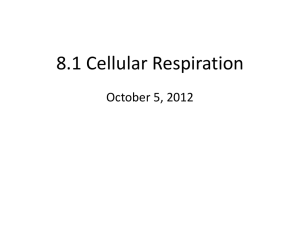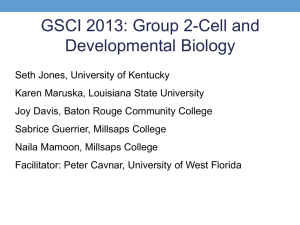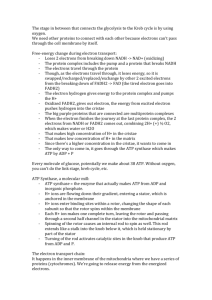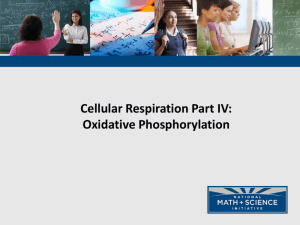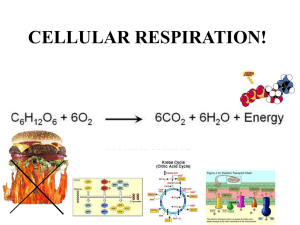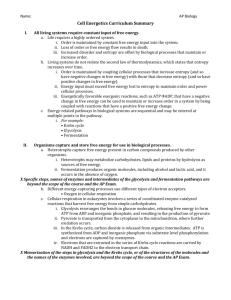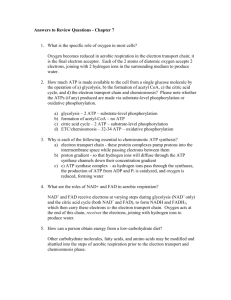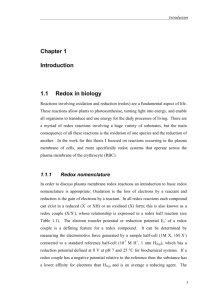Bio102 Problems Aerobic Respiration
advertisement
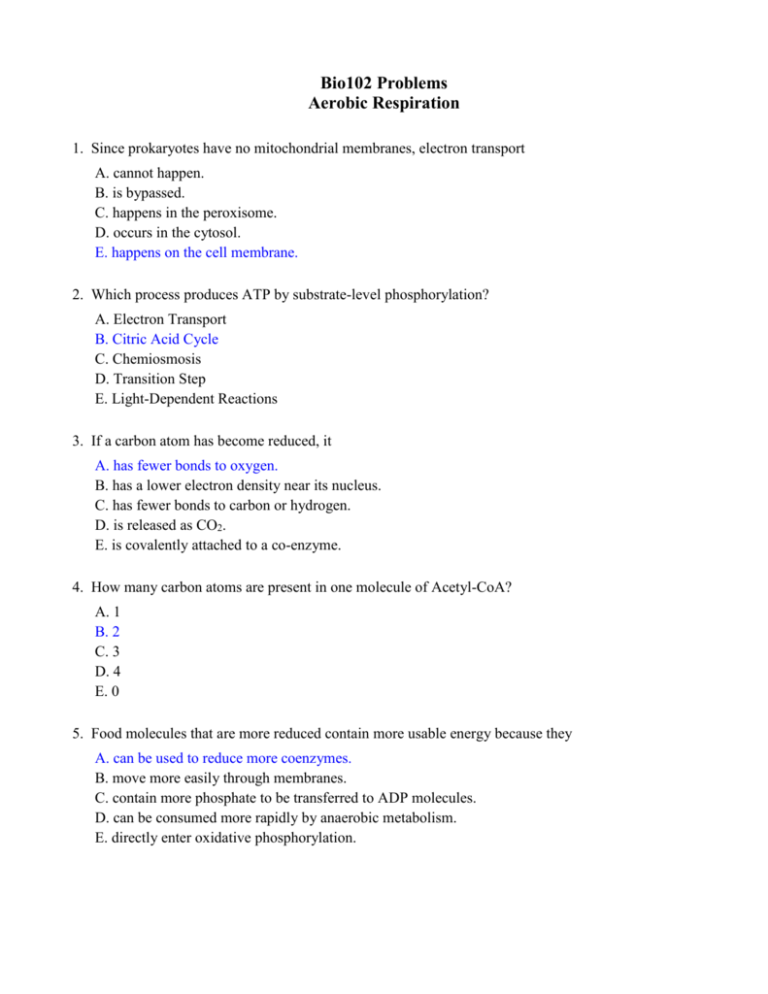
Bio102 Problems Aerobic Respiration 1. Since prokaryotes have no mitochondrial membranes, electron transport A. cannot happen. B. is bypassed. C. happens in the peroxisome. D. occurs in the cytosol. E. happens on the cell membrane. 2. Which process produces ATP by substrate-level phosphorylation? A. Electron Transport B. Citric Acid Cycle C. Chemiosmosis D. Transition Step E. Light-Dependent Reactions 3. If a carbon atom has become reduced, it A. has fewer bonds to oxygen. B. has a lower electron density near its nucleus. C. has fewer bonds to carbon or hydrogen. D. is released as CO2. E. is covalently attached to a co-enzyme. 4. How many carbon atoms are present in one molecule of Acetyl-CoA? A. 1 B. 2 C. 3 D. 4 E. 0 5. Food molecules that are more reduced contain more usable energy because they A. can be used to reduce more coenzymes. B. move more easily through membranes. C. contain more phosphate to be transferred to ADP molecules. D. can be consumed more rapidly by anaerobic metabolism. E. directly enter oxidative phosphorylation. 6. Why does the oxidation of one molecule of FADH2 yield less usable energy than oxidation of one molecule of NADH? When re-oxidized, the electrons from FADH2 enter the electron transport chain in Complex II. The electrons from NADH enter the electron transport chain in Complex I. Complex I pumps protons across the mito inner membrane, but Complex II does not. The moved protons are eventually used to synthesize ATP. 7. Formic acid, which contains a single carbon atom, is shown below. In the corresponding boxes, draw the structure of a different molecule which is one step more oxidized than formic acid and then another that is one step more reduced than formic acid. Formic Acid One step more oxidized One step more reduced O O H-C-OH CO2 H-C-H 8. In aerobic metabolism, what process (or processes) produces CO2? Transitions Step, Citric Acid Cycle 9. For the electron transport chain used in aerobic metabolism, the initial electron donor is __NADH/FADH2______, the final electron acceptor is __O2______________, and the electron has gained/lost energy during transport. 10. When protons are moved across the mitochondrial inner membrane in the electron transport chain, this is one type of A. facilitated transport. B. simple diffusion. C. active transport. D. pinocytosis. E. exocytosis. 11. Circle the letter of the molecule whose carbon atom has the most usable cellular energy. A. CO2 B. CH3OH C. CH4 D. HCOH || O 12. In our discussions of oxidative phosphorylation, we mainly discussed the mitochondrial inner membrane. Prokaryotes can also carry out electron transport and oxidative phosphorylation, but prokaryotes have no mitochondria. How does oxidative phosphorylation in prokaryotes happen without a mitochondrial membrane? The plasma membrane is used instead. 13. The structure of acetaldehyde is shown below. This can be a substrate for two different enzymes that use two different coenzymes, as shown. For each oxidation/reduction reaction, draw the structure of a possible product. A. and NADPH B. and FAD and NADP+ CH3-CH2OH CH3-COOH and FADH2 14. Cyanide is poisonous to people because it blocks oxidative phosphorylation by directly binding to one of the essential proteins. Why does treating cells with cyanide also cause the Transition Step to quickly stop? Without oxidative phosphorylation, the coenzymes NADH and FADH2 can’t become reoxidized. In the absence of NAD+ and FAD, the citric acid cycle stops working since those are essential substrates. 15. How many carbon atoms are in each of the following molecules? AcCoA ___2_____ Glucose ___6_____ Pyruvate ___3_____ 16. Are each of the following reactions an oxidation reaction, a reduction reaction, both or neither? NADP+ → NADPH Oxidation Reduction Both Neither ADP + PO4 → ATP Oxidation Reduction Both Neither Oxidation Reduction Both Neither 17. We can isolate mitochondria from liver cells and measure the rate at which electron transport proceeds as well as their ability to make ATP. Then we can modify their phospholipids and observe the following effects: 17A. If we modify the phospholipids in the mitochondria so that they are less unsaturated, we find the rate at which electron transport proceeds decreases substantially as does the amount of ATP synthesized. Please briefly explain why less unsaturated phospholipids cause these effects. Less unsaturated phospholipids decreases the fluidity and permeability of the membrane. It’s likely that the fluidity fell so much that the complexes can’t move around well and thus can’t transfer elelctrons efficiently. 17B. Alternatively, if we modify the phospholipids in the mitochondria so that they are more unsaturated, we find that electron transport proceeds well, but very little ATP is made. Please briefly explain why more unsaturated phospholipids cause these effects. Less-saturated phospholipids makes the membrane more fluid and also more permeable. It’s likely that it is now so permeable that the protons can diffuse across the inner membrane without passing through ATP synthase. 17C. Based on the above data, what do you think would happen to the rate of electron transport and the amount of ATP made if we added cholesterol to the membrane? Why? This should make the membrane less fluid and less permeable, so it should mimic the outcome of part 17A: decreased electron transport and decreased ATP synthesis 18. The following reaction requires a coenzyme. Is NAD+ or NADH the second substrate? Briefly explain how you arrived at your answer. Substrate: NAD+ or NADH The middle carbon on the substrate molecule is getting oxidized (going from one bond to oxygen to two bonds to oxygen). Thus, the coeznyme must be getting reduced, so we need to start with the oxidized form of the coenzyme.

